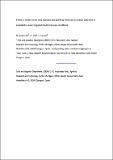Por favor, use este identificador para citar o enlazar a este item:
http://hdl.handle.net/10261/42093COMPARTIR / EXPORTAR:
 SHARE SHARE
 CORE
BASE CORE
BASE
|
|
| Visualizar otros formatos: MARC | Dublin Core | RDF | ORE | MODS | METS | DIDL | DATACITE | |

| Título: | Effect of winter cover crop species and planting methods on maize yield and N availability under irrigated Mediterranean conditions |
Autor: | Salmerón Cortasa, Montserrat; Isla Climente, Ramón CSIC ORCID; Cavero Campo, José CSIC ORCID | Palabras clave: | Cover crops Direct seeding Maize Nitrogen SPAD Tillage |
Fecha de publicación: | ago-2011 | Editor: | Elsevier | Citación: | Salmerón M, Isla R, Cavero J. Effect of winter cover crop species and planting methods on maize yield and N availability under irrigated Mediterranean conditions. Field Crops Research 123 (2): 89-99 (2011) | Resumen: | Under semiarid Mediterranean conditions irrigated maize has been associated to diffuse nitrate pollution of surface and groundwater. Cover crops grown during winter combined with reduced N fertilization to maize could reduce N leaching risks while maintaining maize productivity. A field experiment was conducted testing two different cover crop planting methods (direct seeding versus seeding after conventional tillage operations) and five different cover crops species (barley, oilseed rape, winter rape, common vetch, and a control (bare soil)). The experiment started in November 2006 after a maize crop fertilized with 300 kg N ha-1 and included two complete cover crop-maize rotations. Maize was fertilized with 300 kg N ha-1 at the control treatment, and this amount was reduced to 250 kg N ha-1 in maize after a cover crop. Direct seeding of the cover crops allowed earlier planting dates than seeding after conventional tillage, producing greater cover crop biomass and N uptake of all species in the first year. In the following year, direct seeding did not increase cover crop biomass due to a poorer plant establishment. Barley produced more biomass than the other species but its N concentration was much lower than in the other cover crops, resulting in higher C:N ratio (>26). Cover crops reduced the N leaching risks as soil N content in spring and at maize harvest was reduced compared to the control treatment. Maize yield was reduced by 4 Mg ha-1 after barley in 2007 and by 1 Mg ha-1 after barley and oilseed rape in 2008. The maize yield reduction was due to an N deficiency caused by insufficient N mineralization from the cover crops due to a high C:N ratio (barley) or low biomass N content (oilseed rape) and/or lack of synchronization with maize N uptake. Indirect chlorophyll measurements in maize leaves were useful to detect N deficiency in maize after cover crops. The use of vetch, winter rape and oilseed rape cover crops combined with a reduced N fertilization to maize was efficient for reducing N leaching risks while maintaining maize productivity. However, the reduction of maize yield after barley makes difficult its use as cover crop. | Descripción: | 35 Pag., 7 Tabl., 3 Fig. The definitive version is available at: http://www.sciencedirect.com/science/journal/03784290 | Versión del editor: | http://dx.doi.org/10.1016/j.fcr.2011.05.006 | URI: | http://hdl.handle.net/10261/42093 | DOI: | 10.1016/j.fcr.2011.05.006 | ISSN: | 0378-4290 |
| Aparece en las colecciones: | (EEAD) Artículos |
Ficheros en este ítem:
| Fichero | Descripción | Tamaño | Formato | |
|---|---|---|---|---|
| SalmeronM_FieldCropRes_2011.pdf | 420,85 kB | Adobe PDF |  Visualizar/Abrir |
CORE Recommender
SCOPUSTM
Citations
74
checked on 18-abr-2024
WEB OF SCIENCETM
Citations
65
checked on 24-feb-2024
Page view(s)
516
checked on 24-abr-2024
Download(s)
564
checked on 24-abr-2024
Google ScholarTM
Check
Altmetric
Altmetric
NOTA: Los ítems de Digital.CSIC están protegidos por copyright, con todos los derechos reservados, a menos que se indique lo contrario.
